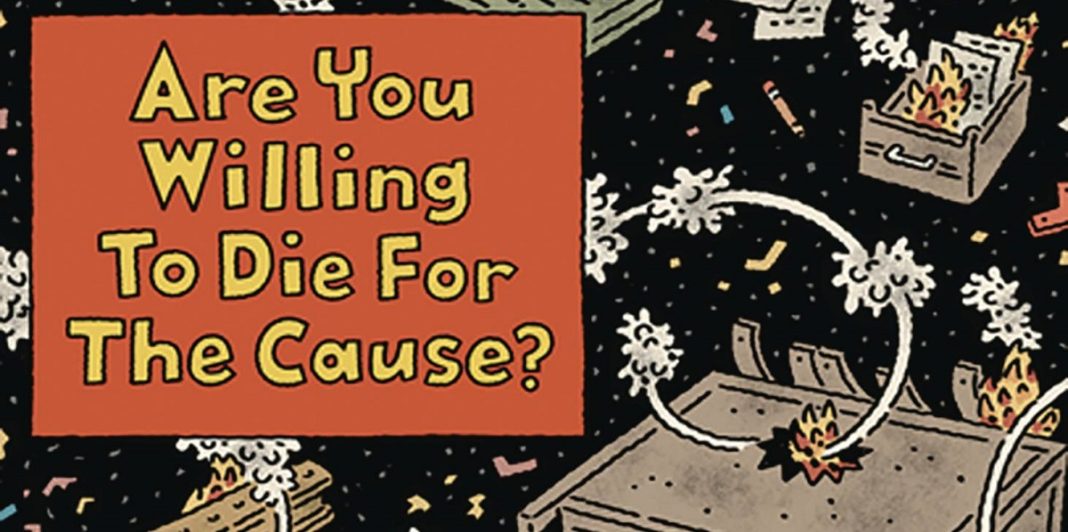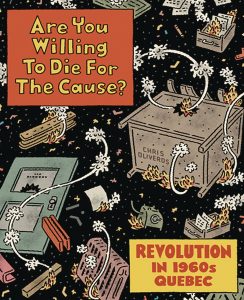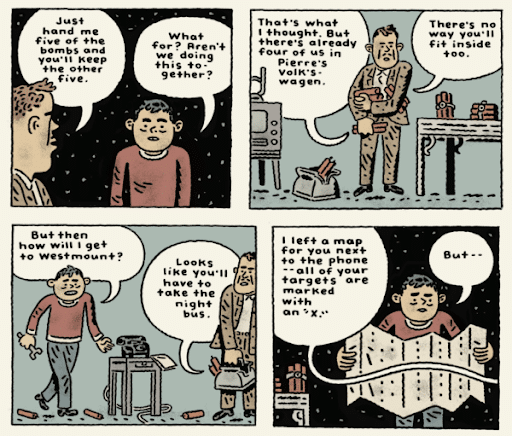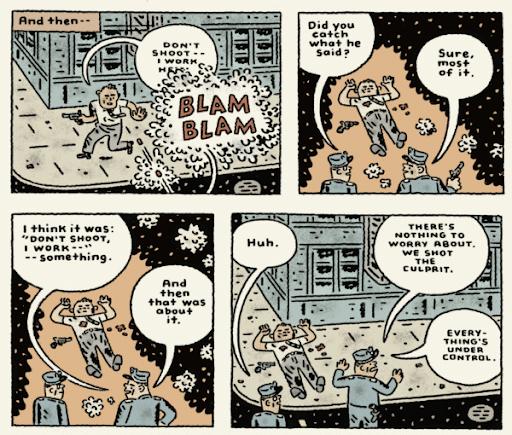 Are You Willing to Die For The Cause?
Are You Willing to Die For The Cause?
Creator: Chris Oliveros
Publisher: Drawn & Quarterly
Review by François Vigneault
A fascinating look at a turbulent and controversial moment in Canadian history, this meticulously researched non-fiction graphic novel from author Chris Oliveros (the founder of comics publisher Drawn & Quarterly) takes a deep dive into the early years of the Québec Liberation Front (FLQ), a militant separatist group that sought to establish an independent nation of Québec in the 1960s and 70s, and which embraced violent means to do so, including lethal bombings.
Taking the form of archival interviews with former members of the FLQ, government officials, journalists, and other witness to the events (in the notes following the narrative Oliveros makes it clear that these interviews did not actually exist, but that the information in them was based on many sources, an authorial sleight-of-hand that makes for a great narrative but may raise eyebrows, mine included), Are You Willing to Die for the Cause? chronicles the rise of separatist actions in Québec during the early 1960s, which might surprise many readers. If you know anything about the FLQ (and to be honest most American readers probably won’t), it will be the infamous “October Crisis” in 1970, where a series of high-profile kidnappings of government officials eventually saw soldiers marching in the streets of Montréal and civil liberties suspended by Prime Minister Pierre Trudeau.

In Oliveros’ telling the founders and early leaders of the FLQ largely come across as comically bumbling and foolish, which is emphasized by the author’s extraordinarily precise yet extremely expressive drawing style that renders lethal explosions and shootouts in a cartoony, almost goofy style, including outsized onomatopoeia such as “BOOM” and “BLAM BLAM.”
Oliveros never shies away from the very real human cost of the FLQ’s actions (and, on occasion, the over-zealous reactions of the police, one of the saddest and most pertinent moments in the book is a scene in which the cops shoot down an innocent man in the street during a robbery gone wrong). Despite the FLQ’s ostensible goal of jump-starting a popular revolution by destroying symbols of colonialism, from the start their campaign of bombings creates unintended victims, from a night watchman who comes across a bomb on the street at the wrong moment and Thérèse Morin, a bookkeeper who dies in an explosion in the offices of a shoe factory, to Jean Corbo, a young member of the FLQ who was blown up at the age of just 16. As the death count mounts, the reader is brought face-to-face with the very real human costs of a burgeoning revolution.
If Oliveros comes up short in this graphic novel, it is perhaps in painting a picture of the sort of everyday oppression and casual prejudice that created the conditions for the rise of the FLQ and separatist thought in the first place. There are scenes that make the generalized anti-francophone and anti-worker biases of big business (run almost entirely by anglophone bosses) clear, and an early moment where a revolutionary plays anglophone talk radio for his wife and she is overwhelmed by the blatant and virulent anti-francophone sentiments on display feels like a clear precursor to the increasing break down of social discourse we are living through today.
But the reader who only has a superficial familiarity with the period (such as myself) will definitely come away with the impression that the FLQ are “just a bunch of two-bit thugs” as Montréal mayor Jean Drapeau calls them in the opening chapter of this book (authority figures, and particularly the violent police force, come across almost as badly). Are You Willing to Die for the Cause? showcases the growth of the FLQ, but I’m not sure if the narrative does enough to describe the soil that it sprang from. Only in the thoughtful appendix does the reader get little tidbits of information such as the fact that in 1961 “francophones were earning barely half of their anglophone counterparts,” or that “the signage in the centre of Montreal was only in English, despite the fact that the anglophone share of the Quebec population was just 13% at the time.”
It would have been great to have these bits of background information folded more directly into the story, but Oliveros is tackling a very big and convoluted period of history in this ambitious book, so his decision to include this information in the paratext of the graphic novel is certainly understandable. Like Alan Moore and Eddie Campbell’s From Hell, this is a dense graphic narrative that demands that the reader make the additional effort to carefully read through the notes, which shed light on the overall context of the era and the creative license that Oliveros applied to the history to make the story flow smoothly across the pages.
What can’t be denied is that this graphic novel clearly situates Oliveros as a major cartooning talent. Every element of this book is meticulously and precisely marshaled for maximum effect, from the cartoony character designs and often hilarious dialogue to Oliveros’ inhumanly precise hand-lettering. After many years of running the publisher Drawn & Quarterly, Oliveros has retired and is now focused on his personal creative work. Are You Ready to Die for the Cause? is the work of an artist who has processed decades worth of cartooning and publishing history and come out with a wholly unique voice. I didn’t know what to expect from Oliveros as a creator and this book left me deeply impressed… He is an author in control of every aspect of his art, and I honestly don’t think it is any exaggeration to say that Oliveros can claim a place in the pantheon of other intensely precise creators such as Seth, Chester Brown, and Chris Ware.
Overall this is a wonderful, impressive, and educational book that is never less than a page-turner. Oliveros keeps the narrative building and the tensions high all the way to the end, where the police find letters from the FLQ that detail plans to kidnap government officials. The cops laugh it off, “As if they could pull any of it off!” But the reader knows that another dark twist remains in this tale, and that the infamous October Crisis is looming. I for one can’t wait to read Oliveros’ take on that chapter of Québec history.
Read more graphic novel reviews in The Beat’s review section!












